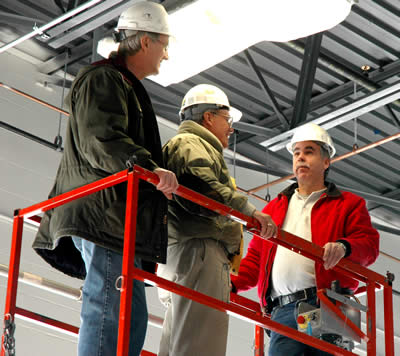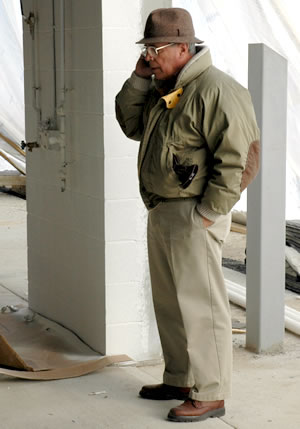|
By Craig Wilkins

Dave Lennartson, an engineering specialist, Dick Post and Cliff Gergen, a Metro District sub-area supervisor, check lighting fixtures in the addition to the Lakeville truck station. Photo by Craig Wilkins |
Dick Post, an architect, serves with the Office of Human Resources and Administration. His job: managing Mn/DOT’s statewide facilities that range from district headquarters buildings to sand and salt storage sites in remote locations.
As a youth growing up in St. Cloud, Post was fascinated by design and how various elements of a drawing, or a building, work together. He knew early on he wanted to become an architect.
Following graduation in facilities management and after earning his architect’s license, Post put his new set of skills to work as a facilities project manager at military installations in the state. He served as the public works director for the Minnesota Army National Guard and earned an award for construction of the new training facility at Camp Ripley near Little Falls.
Post joined Mn/DOT in 2001, and has served as chairman of the state’s Facilities Managers Group.
How did your early interest in art, design and architecture first take form?
I liked to paint and draw. In high school I chose art classes instead of shop. That led to my art teacher and me helping make stained glass windows for the then-new and very modern St. John’s Abbey Church at nearby St. John’s University in Collegeville.
We worked with area craftsmen to follow the vision of renowned modernist architect Marcel Breuer, who designed the futuristic church, its landmark bell tower and other structures.
After high school, I enlisted for a six-year tour with the Marine Corps, including service in Vietnam.
After my discharge, I did construction work. Pouring concrete on the roof a building one frigid December morning really convinced me to consider other aspects of the construction business.
What did you decide that day?
I decided to use the G.I. Bill and go to college. I chose Louisiana State University in Baton Rouge because it was warm there, affordable and its architecture school supported the ‘form-follows-function design’ philosophy.

Dick Post takes a phone call during a visit to the Lakeville truck station. Photo by Craig Wilkins |
How have you combined your interests in aesthetics and functionality?
I’ve become more involved in the construction aspects more than design side of buildings, but I am convinced form and function can work together harmoniously. In the same vein, we can build environmentally friendly buildings that are attractive and still do what they’re supposed to do.
You won an award for your work at Camp Ripley; what do you consider your most important work at Mn/DOT?
A new district headquarters building at Mankato, if we get it.
At Mn/DOT, we’ve been able to establish a commonality of building standards and processes to make building new structures and modifying existing ones easier, faster and more economical.
At the state level, we’re very close to having a common software program that will allow agencies to share standards and other information needed to make the best decisions about building needs and priorities.
Our projects, such as the design and construction of the Thief River Falls Joint Operations Center and the new, energy-efficient Litchfield truck station, have also been very rewarding.
The building at Thief River houses Mn/DOT, the Department of Natural Resources, the State Patrol and the city and county highway departments. The facility has become a community asset and focal point.
The Litchfield facility uses an underground heat pump exchange system for building heating and cooling.
We use other measures to cut back energy consumption when buildings are not in use. We’re making better use of light to save energy, and to create more attractive work environments. Using heated floors is efficient and contributes to safety by keeping water and other liquids from freezing on the floor.
What excites you about the future?
We are now investigating the feasibility of using wind turbines to generate electricity for truck stations and other facilities. This promises a very exciting possibility to cut energy costs and improve efficiency in the future.
Do you or a co-worker have an interesting job to share with readers? Click here to send us your ideas, and we’ll contact you for more information.
Recent employee profiles:
|



